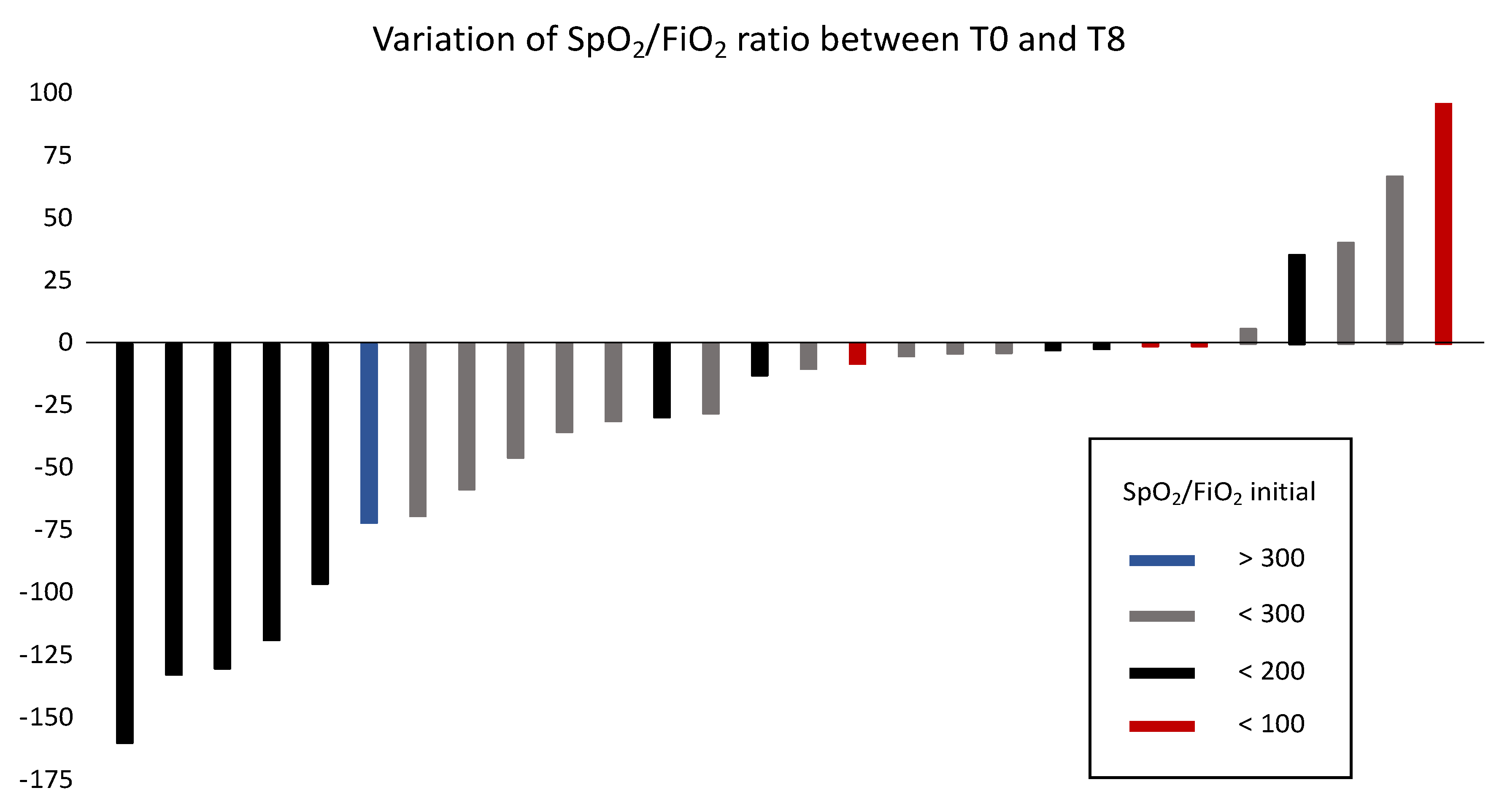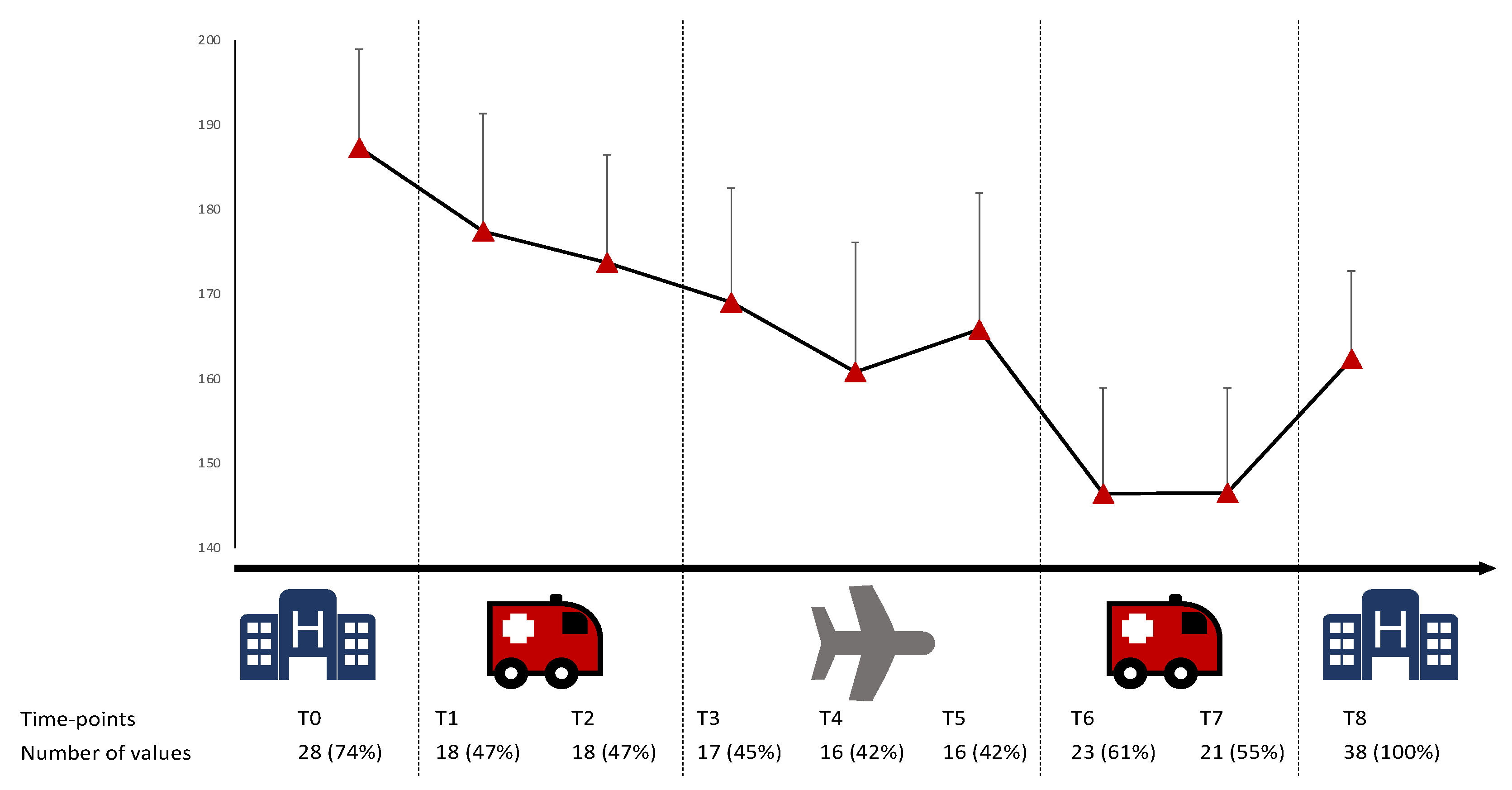Impact of Air Transport on SpO2/FiO2 among Critical COVID-19 Patients during the First Pandemic Wave in France
Abstract
:1. Introduction
2. Materials and Methods
2.1. Air Medical Transport
2.2. Data Collection
2.3. Data Analysis
2.4. Ethics
3. Results
3.1. Study Population
3.2. Primary Outcome
3.3. Factors Associated with Changes in SpO2/FiO2 during Transport
3.4. Evolution of SpO2/FiO2 during the Transport
4. Discussion
4.1. ARDS in COVID-19
4.2. The Link between PaO2/FiO2 and SpO2/FiO2
4.3. The Necessity to Help Overcrowded Areas
4.4. Impact of Landing and Team Switch
4.5. Limitations
5. Conclusions
Author Contributions
Funding
Institutional Review Board Statement
Informed Consent Statement
Data Availability Statement
Conflicts of Interest
Appendix A
| Characteristics | Mean ± SD n (%) Full Data (n = 12) | Mean ± SD n (%) Missing Data (n = 26) | Hedge’s IgI or Effect Size |
|---|---|---|---|
| Age (years) | 60.3 ± 10.5 | 63.4 ± 11.4 | −0.279 |
| Height (cm) | 169.2 ± 10.4 | 173.5 ± 9.7 | −0.431 |
| Weight (kg) | 82.4 ± 11.8 | 91.4 ± 25.2 | −0.404 |
| Body Mass Index (kg/m2) | 28.7 ± 3.1 | 30.3 ± 6.8 | −0.262 |
| Vital signs in initial intensive care unit | |||
| Systolic Blood Pressure (mmHg) | 126.6 ± 31 | 118.9 ± 26.8 | 0.251 |
| Diastolic Blood Pressure (mmHg) | 70.4 ± 22 | 62.3 ± 19.2 | 0.347 |
| Mean Blood Pressure (mmHg) | 89.1 ± 23.7 | 81.2 ± 18.7 | 0.373 |
| Heart Rate (pulse per minute) | 78.3 ± 15 | 81.9 ± 13.8 | −0.237 |
| SpO2 (%) | 96.2 ± 3.1 | 94.1 ± 4 | 0.539 |
| FiO2 (%) | 53.3 ± 12.5 | 60.1 ± 25.6 | −0.351 |
| SpO2/FiO2 | 192.1 ± 56 | 183.8 ± 66.6 | 0.129 |
| Sex | |||
| Male | 8 (66.7) | 17 (65.4) | 0.027 |
| Female | 4 (33.3) | 9 (34.6) | |
| Medical History | |||
| Diabetes | 2 (16.7) | 11 (42.3) | −0.586 |
| Hypertension | 4 (33.3) | 12 (46.2) | −0.264 |
| Dyslipidemia | 0 | 7 (26.9) |
References
- Chan, J.F.-W.; Yuan, S.; Kok, K.-H.; To, K.K.-W.; Chu, H.; Yang, J.; Xing, F.; Liu, J.; Yip, C.C.-Y.; Poon, R.W.-S.; et al. A Familial Cluster of Pneumonia Associated with the 2019 Novel Coronavirus Indicating Person-to-Person Transmission: A Study of a Family Cluster. Lancet 2020, 395, 514–523. [Google Scholar] [CrossRef] [Green Version]
- Teslya, A.; Pham, T.M.; Godijk, N.G.; Kretzschmar, M.E.; Bootsma, M.C.J.; Rozhnova, G. Impact of Self-Imposed Prevention Measures and Short-Term Government-Imposed Social Distancing on Mitigating and Delaying a COVID-19 Epidemic: A Modelling Study. PLoS Med. 2020, 17, e1003166. [Google Scholar] [CrossRef] [PubMed]
- Dhont, S.; Derom, E.; Van Braeckel, E.; Depuydt, P.; Lambrecht, B.N. The Pathophysiology of “happy” Hypoxemia in COVID-19. Respir. Res. 2020, 21, 198. [Google Scholar] [CrossRef] [PubMed]
- Navas-Blanco, J.R.; Dudaryk, R. Management of Respiratory Distress Syndrome Due to COVID-19 Infection. BMC Anesthesiol. 2020, 20, 177. [Google Scholar] [CrossRef]
- Ranieri, V.M.; Rubenfeld, G.D.; Thompson, B.T.; Ferguson, N.D.; Caldwell, E.; Fan, E.; Camporota, L.; Slutsky, A.S.; ARDS Definition Task Force. Acute Respiratory Distress Syndrome: The Berlin Definition. JAMA 2012, 307, 2526–2533. [Google Scholar] [CrossRef]
- Rice, T.W.; Wheeler, A.P.; Bernard, G.R.; Hayden, D.L.; Schoenfeld, D.A.; Ware, L.B.; National Institutes of Health. National Heart, Lung, and Blood Institute ARDS Network Comparison of the SpO2/FIO2 Ratio and the PaO2/FIO2 Ratio in Patients with Acute Lung Injury or ARDS. Chest 2007, 132, 410–417. [Google Scholar] [CrossRef] [PubMed]
- Chen, W.; Janz, D.R.; Shaver, C.M.; Bernard, G.R.; Bastarache, J.A.; Ware, L.B. Clinical Characteristics and Outcomes Are Similar in ARDS Diagnosed by Oxygen Saturation/FiO2 Ratio Compared with PaO2/FiO2 Ratio. Chest 2015, 148, 1477–1483. [Google Scholar] [CrossRef] [Green Version]
- Gostin, L.O.; Hodge, J.G.; Wiley, L.F. Presidential Powers and Response to COVID-19. JAMA 2020, 323, 1547–1548. [Google Scholar] [CrossRef] [Green Version]
- Sandford, A. Coronavirus: Half of Humanity on Lockdown in 90 Countries. Available online: https://www.euronews.com/2020/04/02/coronavirus-in-europe-spain-s-death-toll-hits-10-000-after-record-950-new-deaths-in-24-hou (accessed on 19 April 2020).
- Le Borgne, P.; Oberlin, M.; Bassand, A.; Abensur Vuillaume, L.; Gottwalles, Y.; Noizet, M.; Gennai, S.; Baicry, F.; Jaeger, D.; Girerd, N.; et al. Pre-Hospital Management of Critically Ill Patients with SARS-CoV-2 Infection: A Retrospective Multicenter Study. J. Clin. Med. 2020, 9, 3744. [Google Scholar] [CrossRef]
- Firew, T.; Sano, E.D.; Lee, J.W.; Flores, S.; Lang, K.; Salman, K.; Greene, M.C.; Chang, B.P. Protecting the Front Line: A Cross-Sectional Survey Analysis of the Occupational Factors Contributing to Healthcare Workers’ Infection and Psychological Distress during the COVID-19 Pandemic in the USA. BMJ Open 2020, 10, e042752. [Google Scholar] [CrossRef]
- Bouillon-Minois, J.-B.; Schmidt, J.; Dutheil, F. SARS-CoV-2 Pandemic and Emergency Medicine: The Worst Is yet to Come. Am. J. Emerg. Med. 2020. [Google Scholar] [CrossRef] [PubMed]
- Bouillon-Minois, J.-B.; Raconnat, J.; Clinchamps, M.; Schmidt, J.; Dutheil, F. Emergency Department and Overcrowding During COVID-19 Outbreak; a Letter to Editor. Arch. Acad. Emerg. Med. 2021, 9, e28. [Google Scholar] [CrossRef] [PubMed]
- Tabah, A.; Ramanan, M.; Laupland, K.B.; Buetti, N.; Cortegiani, A.; Mellinghoff, J.; Conway Morris, A.; Camporota, L.; Zappella, N.; Elhadi, M.; et al. Personal Protective Equipment and Intensive Care Unit Healthcare Worker Safety in the COVID-19 Era (PPE-SAFE): An International Survey. J. Crit. Care 2020, 59, 70–75. [Google Scholar] [CrossRef]
- Gattinoni, L.; Coppola, S.; Cressoni, M.; Busana, M.; Rossi, S.; Chiumello, D. COVID-19 Does Not Lead to a “Typical” Acute Respiratory Distress Syndrome. Am. J. Respir. Crit. Care Med. 2020, 201, 1299–1300. [Google Scholar] [CrossRef] [Green Version]
- Guan, W.-J.; Ni, Z.-Y.; Hu, Y.; Liang, W.-H.; Ou, C.-Q.; He, J.-X.; Liu, L.; Shan, H.; Lei, C.-L.; Hui, D.S.C.; et al. Clinical Characteristics of Coronavirus Disease 2019 in China. N. Engl. J. Med. 2020, 382, 1708–1720. [Google Scholar] [CrossRef] [PubMed]
- Brown, S.M.; Grissom, C.K.; Moss, M.; Rice, T.W.; Schoenfeld, D.; Hou, P.C.; Thompson, B.T.; Brower, R.G. Nonlinear Imputation of PaO2/FIO2 from Spo2/FIO2 among Patients with Acute Respiratory Distress Syndrome. Chest 2016, 150, 307–313. [Google Scholar] [CrossRef] [Green Version]
- Wenzhong, L.; Hualan, L. COVID-19: Attacks the 1-Beta Chain of Hemoglobin and Captures the Porphyrin to Inhibit Human Heme Metabolism. ChemRxiv 2020. [Google Scholar] [CrossRef]
- Azoulay, É.; Beloucif, S.; Guidet, B.; Pateron, D.; Vivien, B.; Le Dorze, M. Admission Decisions to Intensive Care Units in the Context of the Major COVID-19 Outbreak: Local Guidance from the COVID-19 Paris-Region Area. Crit. Care 2020, 24, 293. [Google Scholar] [CrossRef]
- Savary, D.; Lesimple, A.; Beloncle, F.; Morin, F.; Templier, F.; Broc, A.; Brochard, L.; Richard, J.-C.; Mercat, A. Reliability and Limits of Transport-Ventilators to Safely Ventilate Severe Patients in Special Surge Situations. Ann. Intensive Care 2020, 10, 166. [Google Scholar] [CrossRef]
- Adnet, F.; Lapostolle, F. International EMS Systems: France. Resuscitation 2004, 63, 7–9. [Google Scholar] [CrossRef]
- Papson, J.P.N.; Russell, K.L.; Taylor, D. McD. Unexpected Events during the Intrahospital Transport of Critically Ill Patients. Acad. Emerg. Med. 2007, 14, 574–577. [Google Scholar] [CrossRef] [PubMed]
- Allen, R.; Wanersdorfer, K.; Zebley, J.; Shapiro, G.; Coullahan, T.; Sarani, B. Interhospital Transfer of Critically Ill Patients Because of Coronavirus Disease 19–Related Respiratory Failure. Air Med. J. 2020, 39, 498–501. [Google Scholar] [CrossRef] [PubMed]
- Davis, D.P.; Aguilar, S.; Sonnleitner, C.; Cohen, M.; Jennings, M. Latency and Loss of Pulse Oximetry Signal with the Use of Digital Probes during Prehospital Rapid-Sequence Intubation. Prehosp Emerg Care 2011, 15, 18–22. [Google Scholar] [CrossRef] [PubMed]
- Vicenzi, M.; Di Cosola, R.; Ruscica, M.; Ratti, A.; Rota, I.; Rota, F.; Bollati, V.; Aliberti, S.; Blasi, F. The Liaison between Respiratory Failure and High Blood Pressure: Evidence from COVID-19 Patients. Eur. Respir. J. 2020, 56, 2001157. [Google Scholar] [CrossRef] [PubMed]



| Characteristics | Mean ± SD n (%) |
|---|---|
| Age (years) | 62.4 ± 11.1 |
| Height (cm) | 172.2 ± 10 |
| Weight (kg) | 88.6 ± 22.1 |
| Body Mass Index (kg/m2) | 29.8 ± 5.9 |
| Length of hospitalization in intensive care unit (days) | 22.8 ± 17.5 |
| Vital signs in initial intensive care unit | |
| Systolic Blood Pressure (mmHg) | 124 ± 29 |
| Diastolic Blood Pressure (mmHg) | 67 ± 21 |
| Mean Blood Pressure (mmHg) | 86 ± 22 |
| Heart Rate (pulse per minute) | 80 ± 14 |
| SpO2 (%) | 95 ± 4 |
| FiO2 (%) | 58 ± 21 |
| SpO2/FiO2 | 187.3 ± 61.3 |
| Vital signs in arrival intensive care unit | |
| Systolic Blood Pressure (mmHg) | 124 ± 26 |
| Diastolic Blood Pressure (mmHg) | 67 ± 13 |
| Mean Blood Pressure (mmHg) | 86 ± 15 |
| Heart Rate (pulse per minute) | 84 ± 20 |
| SpO2 (%) | 94 ± 7 |
| FiO2 (%) | 67 ± 25 |
| SpO2/FiO2 | 162.3 ± 64.3 |
| Sex | |
| Male | 25 (65.8) |
| Female | 13 (34.2) |
| Medical History | |
| Diabetes | 13 (34.2) |
| Hypertension | 16 (42.1) |
| Dyslipidemia | 7 (18.4) |
| Date of transport | |
| 28 March | 10 (26.3) |
| 29 March | 8 (21.1) |
| 30 March | 1 (2.6) |
| 3 April | 6 (15.8) |
| 4 April | 12 (31.6) |
| 5 April | 1 (2.6) |
| Type of flight | |
| A400m | 11 (29.7) |
| Small plane | 11 (29.7) |
| Helicopter | 15 (40.5) |
| Type of sedative | |
| Midazolam | 18 (47.4) |
| Propofol | 6 (15.8) |
| Midazolam + Propofol | 9 (23.7) |
| Missing Data | 5 (13.2) |
| Type of analgesia | |
| Remifentanil | 2 (5.3) |
| Sufentanyl | 31 (81.6) |
| Missing Data | 5 (13.2) |
| Mortality | |
| 7 days | 1 (2.6) |
| 30 days | 9 (23.7) |
Publisher’s Note: MDPI stays neutral with regard to jurisdictional claims in published maps and institutional affiliations. |
© 2021 by the authors. Licensee MDPI, Basel, Switzerland. This article is an open access article distributed under the terms and conditions of the Creative Commons Attribution (CC BY) license (https://creativecommons.org/licenses/by/4.0/).
Share and Cite
Bouillon-Minois, J.-B.; Roux, V.; Jabaudon, M.; Flannery, M.; Duchenne, J.; Dumesnil, M.; Paillard-Turenne, M.; Gendre, P.-H.; Grapin, K.; Rieu, B.; et al. Impact of Air Transport on SpO2/FiO2 among Critical COVID-19 Patients during the First Pandemic Wave in France. J. Clin. Med. 2021, 10, 5223. https://doi.org/10.3390/jcm10225223
Bouillon-Minois J-B, Roux V, Jabaudon M, Flannery M, Duchenne J, Dumesnil M, Paillard-Turenne M, Gendre P-H, Grapin K, Rieu B, et al. Impact of Air Transport on SpO2/FiO2 among Critical COVID-19 Patients during the First Pandemic Wave in France. Journal of Clinical Medicine. 2021; 10(22):5223. https://doi.org/10.3390/jcm10225223
Chicago/Turabian StyleBouillon-Minois, Jean-Baptiste, Vincent Roux, Matthieu Jabaudon, Mara Flannery, Jonathan Duchenne, Maxime Dumesnil, Morgane Paillard-Turenne, Paul-Henri Gendre, Kévin Grapin, Benjamin Rieu, and et al. 2021. "Impact of Air Transport on SpO2/FiO2 among Critical COVID-19 Patients during the First Pandemic Wave in France" Journal of Clinical Medicine 10, no. 22: 5223. https://doi.org/10.3390/jcm10225223
APA StyleBouillon-Minois, J.-B., Roux, V., Jabaudon, M., Flannery, M., Duchenne, J., Dumesnil, M., Paillard-Turenne, M., Gendre, P.-H., Grapin, K., Rieu, B., Dutheil, F., Croizier, C., Schmidt, J., & Pereira, B. (2021). Impact of Air Transport on SpO2/FiO2 among Critical COVID-19 Patients during the First Pandemic Wave in France. Journal of Clinical Medicine, 10(22), 5223. https://doi.org/10.3390/jcm10225223









